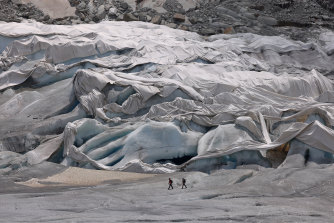
Scientists have been baffled as to why the Larsen ice shelves were melting. They knew high air temperatures were causing surface ice to melt. They knew the water would trickle into the cracks in the ice shelf, expand as it froze and break off the ice. But they couldn’t figure out what was causing the warm air temperatures.
Clem studied 25 years of data that showed the worst surface melting occurred when intense atmospheric “rivers” – concentrated ribbons of water vapour moving within the lowest three kilometres of the Earth’s atmosphere – swept through the area.
His research, published this week in Nature Communications, found these “rivers” were caused by air circulation patterns and thunderstorms originating from the region east of Fiji in the tropical Pacific Ocean. These “rivers” are responsible for driving a number of climate events, including increasing high-temperature extremes and ice melt when they move over the Antarctic Peninsula, or exceptionally heavy rainfall, such as the weather event that smashed NSW last week.
He said that scientists previously thought the ozone layer could be behind the melting ice shelves, but his finding could help researchers predict future melting events in the area.
Loading
“There are about five or fewer atmospheric rivers that exist any time across the world and they are responsible for transporting up to 90 per cent of moisture in the tropics to higher latitudes,” he said.
“As global temperatures increase, the amount of moisture in the atmosphere also increases and the amount of moisture that atmospheric rivers can transport is increasing.
“When there is the increasing intensity of atmospheric rivers, this can lead to new extremes and that can look like extra precipitation, such as the catastrophic flooding we’ve seen over Australia and more extreme warm temperatures in Antarctica.”
Globally, June 2022 had the second-lowest June sea ice coverage on record, with sea ice in the Antarctic at a record low of 12.12 million square kilometres – about 1.2 million square kilometres below average, data released on Thursday from the National Oceanic and Atmospheric Administration found.
Loading
Meanwhile, the extent of Arctic sea ice last month was 8 million square kilometres below the 1981 to 2010 average, which is roughly the size of Sweden, Norway and Denmark combined. It comes as June’s average global temperature was the sixth warmest on record.
CSIRO oceans and atmosphere fellow Dr Steve Rintoul said the warm weather was causing additional pressures on marine life, with penguin colonies already experiencing rainfall rather than snowfall.
He added that, in some areas, grasses typically found on golf courses had started growing, while crabs from warmer regions had migrated.
“The prospect of all the ice melting is not imminent and it may never happen,” he said.
“The projected sea level rise by the end of the century is about one metre ... but we commit ourselves by the decisions we make in the next decade or so to changes that will be irreversible. If we don’t act soon to slow greenhouse gas emissions, we risk crossing a threshold where the ice sheet starts to retreat and, once it starts, we can’t stop it.

Alpinists hiking on the receding Rhone glacier walk past a portion at the very bottom of the glacier that is covered in reflective tarp on June 20, 2022.Credit:Getty Images
“We can’t decide in 50 years we don’t want sea level rise. We make that commitment now.”
Meanwhile, as heatwaves sweep across Europe, blankets have been placed on the Rhone Glacier in Switzerland. The tarps are designed to reflect away the sun’s rays and reduce melt.
A guide to the environment, what’s happening to it, what’s being done about it and what it means for the future. Sign up to our fortnightly Clear Air newsletter here.









 Add Category
Add Category